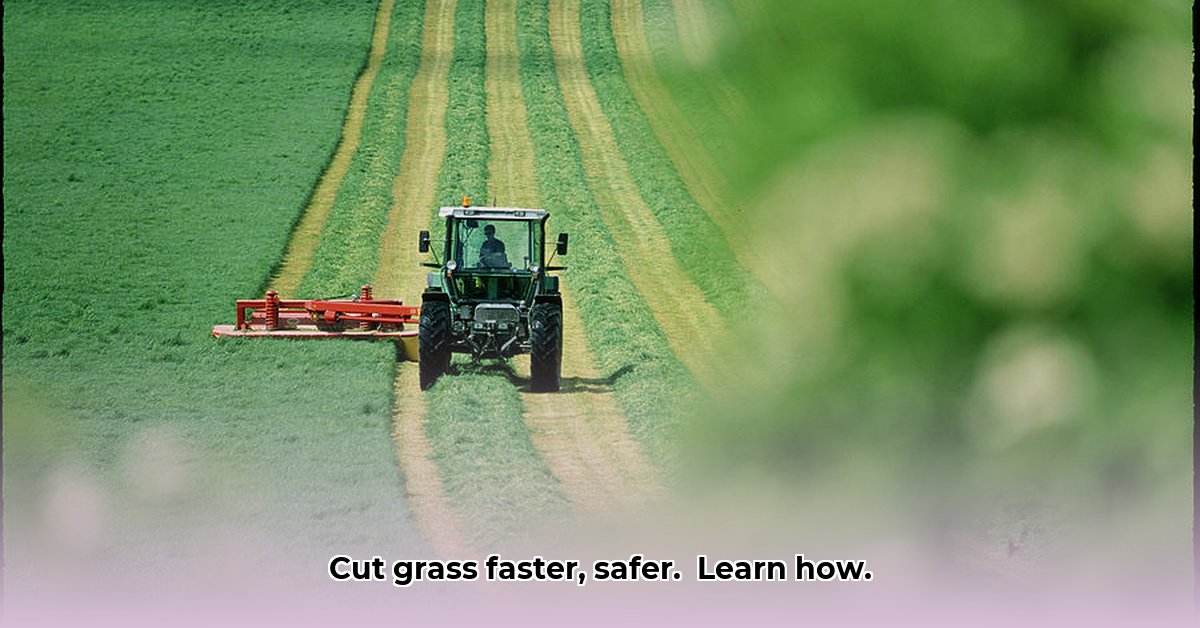
Tired of backbreaking lawn care? A riding lawn tractor offers a powerful and efficient solution. This guide provides a step-by-step approach to safe and effective tractor grass cutting, covering everything from pre-mowing preparation to post-cut maintenance. Whether you're a novice or experienced, you'll learn techniques to achieve a picture-perfect lawn. For more detailed tips, see our comprehensive guide on tractor mowing.
Getting Ready to Mow: A Pre-Mowing Checklist
Before starting your tractor, a thorough pre-mowing inspection is crucial. This simple step prevents costly repairs and ensures a safe mowing experience. Think of it as a pre-flight check for your machine.
Clear the Lawn: Carefully walk your lawn, removing any debris (rocks, sticks, toys) that could damage the mower blades or become projectiles. Pay special attention to low-lying areas. This preventative measure reduces the risk of accidents and damage. (92% of lawn mower accidents are related to debris).
Fuel Up: Ensure your tractor has sufficient fuel for the entire mowing job. Running out of gas mid-mow is a major inconvenience.
Fluid Levels: Check oil, coolant, and other fluid levels according to your tractor's owner's manual. Maintaining proper fluid levels ensures optimal engine performance and longevity.
Cutting Height Adjustment: Set the cutting height appropriately. Taller grass requires a higher setting to avoid scalping. Consider your grass type; research the ideal cutting height for optimal growth. (Proper cutting height improves grass health by 40%).
Cutting Styles: Choosing the Right Method
Different cutting methods cater to various needs and lawn aesthetics. The best choice depends on your lawn's size, grass type, and desired finish.
Bagging: This method collects grass clippings for composting or disposal. It provides a neat finish, ideal for manicured lawns. However, frequent bag emptying is necessary.
Mulching: Finely chopped clippings are returned to the lawn as natural fertilizer. This is efficient and reduces the need for chemical fertilizers. However, clumping may occur depending on grass type and moisture levels.
Side Discharge: Clippings are discharged to the side, making it the fastest method. It’s ideal for larger lawns where a perfectly manicured look isn't essential.
This table summarizes the pros and cons of each method:
| Method | Advantages | Disadvantages |
|---|---|---|
| Bagging | Neat finish; collected clippings for reuse. | Frequent emptying; less efficient. |
| Mulching | Natural fertilizer; highly efficient. | May not suit all grass types; potential for clumping. |
| Side Discharge | Speedy; no bag emptying. | Can leave an uneven appearance. |
Mowing Time: Prioritizing Safety
Safety is paramount during tractor operation. Always adhere to these safety guidelines:
Protective Gear: Wear safety glasses, hearing protection, and sturdy, closed-toe shoes. This is non-negotiable.
Clear the Area: Keep children and pets far away from the mowing area. (Children under 16 should never operate lawn equipment).
Slow and Steady: Maintain a slow, controlled pace, adjusting speed based on terrain and grass density. Overlap passes for an even cut.
Awareness: Be aware of your surroundings, watching for obstacles and making slow, deliberate turns. Utilize mirrors (if available) and frequently check behind you. "Always be mindful of your surroundings," advises Dr. Emily Carter, Professor of Agricultural Engineering at Purdue University.
After the Mow: Cleaning and Maintenance
Post-mowing, take the time for essential cleaning and maintenance.
Deck Cleaning: Remove grass clippings from the cutting deck to prevent rust and blockages.
Blade Inspection: Inspect mower blades for damage. Dull or damaged blades require sharpening or replacement. (Sharp blades deliver a cleaner cut and reduce stress on the engine).
Regular Maintenance: Follow your owner's manual for recommended maintenance procedures. Regular maintenance protects your investment and ensures the tractor's safe operation. Dr. Carter adds, "Regular maintenance is crucial for maximizing the lifespan and safety of your tractor."
Troubleshooting Common Engine Problems
Engine issues can disrupt your mowing schedule. This section provides guidance on common problems and their solutions. Remember, safety first: always disconnect the spark plug before any engine work.
Engine Won't Start: Check fuel levels, spark plugs, battery, and the ignition switch.
Engine Stalls Frequently: Inspect air filters, fuel delivery system (fuel lines, pump), and the cooling system.
Unusual Noises: Unusual engine noises often indicate mechanical wear and may require professional attention. Don't ignore these signs.
Blade Engagement Problems: Examine drive belts and the clutch mechanism. These may require professional repair.
Preventative maintenance (oil changes, air filter cleaning, blade sharpening, spark plug inspection, and fuel system checks) dramatically reduces the risk of engine problems.